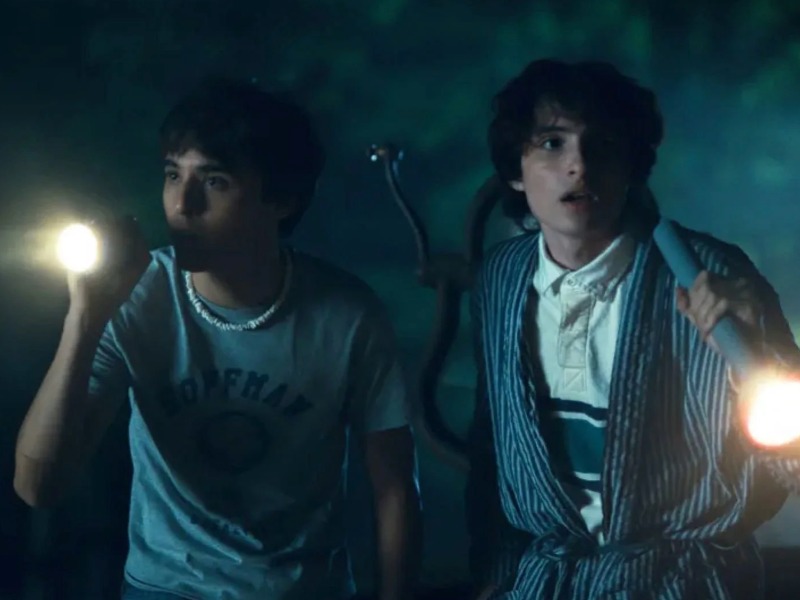Summer, campfires, messy teen crushes, and the lurking dread of something hunting in the shadows — Hell of Summer taps into one of horror’s most beloved playgrounds. Yet, instead of feeling like a tired retread of Friday the 13th or Sleepaway Camp, this film breathes new life into an old setup, thanks to sharp direction by Finn Wolfhard (of Stranger Things fame) and co-director Billy Bryk.
What they’ve crafted is a movie that’s equal parts horror, nostalgia trip, and coming-of-age comedy — a slasher that remembers to let its characters laugh, bicker, and live before the screaming starts.
The Setup – A Familiar but Fun Beginning
The story centers on a group of teenage camp counselors preparing for a summer that, on the surface, looks perfect: lazy days, canoe races, awkward crushes, camp talent shows, and the kind of endless nights that only teenagers on the brink of adulthood can experience.
Of course, this being a slasher, happiness can’t last long. As the days stretch on, something sinister begins haunting the camp — a masked threat that turns the heat of summer into the icy terror of survival. Plot-wise, it might not surprise seasoned horror buffs, but it knows what it is and leans into the formula with a wink.
The Characters – More Than Victims
Where Hell of Summer truly shines is in its characters. Horror is often guilty of reducing teens to one-dimensional archetypes: the jock, the mean girl, the loner, the “final girl.” Here, Wolfhard and Bryk clearly dug into their own experiences of youth and friendship.
The campers and counselors feel like real people. They’re awkward, funny, sometimes annoying, sometimes heroic — in other words, human. Their banter rings true, their crushes clumsy but heartfelt, and when the slasher comes for them, you actually care. That emotional investment adds genuine tension to the kills.
The Style – Equal Parts Retro and Modern
Visually, the film is steeped in classic summer-camp atmosphere: hazy golden sunlight, chirping crickets, and the ever-present glow of the campfire. But the camera work also brings in modern flourishes — the kind of fluid, kinetic shots that give the film a slick feel without losing its grainy, nostalgic edge.
The score matches suit, with synthy throbs mingled with creepy strings, nodding to horror tradition while still feeling fresh.
This balance of “then and now” is perhaps the movie’s biggest strength. It’s not trying to reinvent the wheel — it’s trying to give the wheel just enough of a spin to make you scream while you’re laughing.
The Humor – A Double-Edged Sword
Comedy in horror can be tricky: done right, it elevates the scares. Done wrong, it deflates them. Hell of Summer mostly gets the balance right. Much of the humor feels organic, springing from how teenagers really interact — awkward flirtations, sarcasm, deadpan remarks.
That said, in a few moments, the script leans a little too much into meta territory, where jokes about horror tropes feel more like winks to the audience than natural dialogue. It’s never enough to ruin the tension, but it may pull hardcore horror purists out for a beat.
The Horror – By the Numbers, but Effective
Let’s be clear: Hell of Summer isn’t reinventing the slasher game. You still get masked killers lurking in the shadows, gruesome kills, and isolated woods that seem to swallow sound. But while the formula is familiar, the delivery is effective.
The kills are spread out in a way that escalates tension rather than simply loading up the third act. And unlike many slashers that overdo gore for shock value, this one chooses moments carefully. It’s bloody — but never cartoonishly so.
The fear doesn’t merely come from jump scares; it also comes from atmosphere, from the uneasy dread of being a teen away from home, with danger slowly closing in.
Themes Beneath the Blood
One of the more interesting layers of Hell of Summer is its commentary on growing up. The slasher elements, for all their violence, serve as a metaphor for the awkward, often terrifying leap from adolescence to adulthood.
The camp setting doubles as a crossroads: a place where childhood innocence lingers but reality (and mortality) begins to intrude. Wolfhard and Bryk clearly understand teenage uncertainty, and their script weaves that anxiety into the horror fabric without getting too heavy-handed.
Final Verdict – A Breath of Fresh Summer Air
In the crowded camp of slasher nostalgia, Hell of Summer stands out by pulling off something rare: it honors the classics while feeling distinctly its own. It’s scary without being nihilistic, funny without being hollow, and nostalgic without being stale.
For horror fans, it’s a love letter. For casual viewers, it’s an accessible entry point. For everyone, it’s a reminder that horror — like summer itself — works best when it’s as much about experience as it is about the ending.
⭐ Rating: 4/5 stars
Not flawless, but undeniably fun — Hell of Summer proves the slasher genre still has one hell of a pulse.
